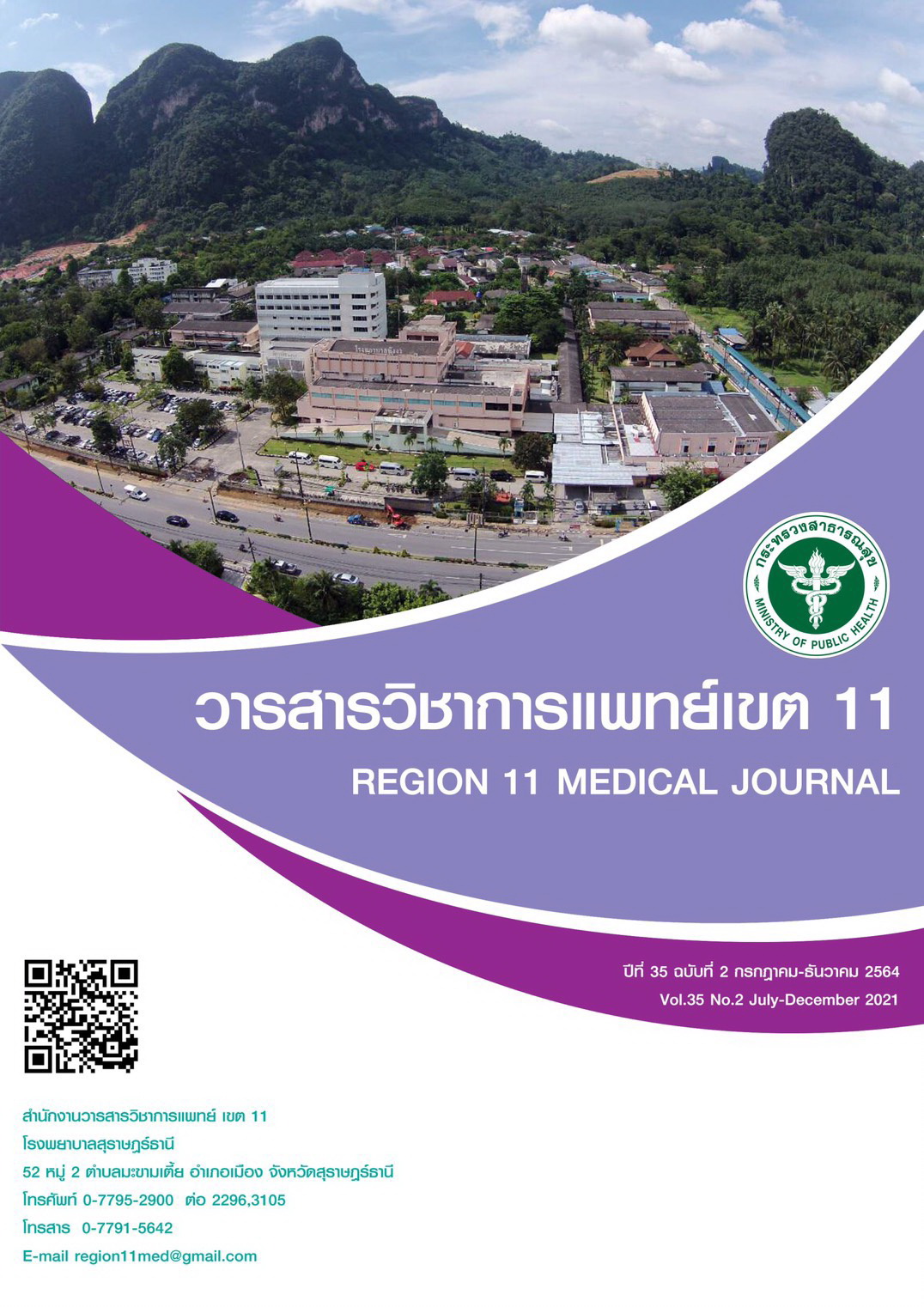Peritonitis in Long-Term Peritoneal Dialysis Patients in Phangnga Hospital
Keywords:
Advanced age, Peritoneal dialysis, Peritonitis, Risk factorAbstract
Background: Peritoneal dialysis in Thailand was increased since the implementation of PD-First policy in 2008. Peritonitis is a major cause of morbidity and mortality among dialysis patients.
Objectives: This study was conducted to identify the incidence and epidemiology data of peritonitis in Phangnga hospital.
Methodology: We reviewed all medical records of patients who follow up in CAPD clinic in Phangnga hospital from October 2016 to September 2019 and adhered with the treatment for at least 1 month. This retrospective descriptive study was focused on the incidence of peritonitis, clinical presentation, causing pathogens, risk factors, and patients’ outcome.
Results: Total 140 patients were included in this study. Fifty-three (37.9%) patients got peritonitis. The incidence of peritonitis from Fiscal year 2017 to 2019 were 0.71, 0.46 and 0.42 episodes per patients per year, respectively. The common clinical symptoms were abdominal pain and cloudy effluent. The most common organism was gram positive cocci (43.2%). The main pathogens were Coagulase-negative staphylococcus (17.8%), Staphylococcus aureus (14.4%) and Escherichia coli (11.9%). The peritonitis increased in patients who age more than 60 years. There were 16 episodes of refractory peritonitis with peritoneal catheter loss with an overall mortality rate of 7.6%
Conclusion: The rate of peritonitis in Phangnga hospital was gradually decreasing and recent two years achieved key performance indicators. Coagulase-negative staphylococcus was the main pathogen. Advanced age was the risk factor of peritonitis.
References
van Esch S, Krediet RT, Struijk DG. Prognostic factors for peritonitis outcome. Contrib Nephrol. 2012;178:264-70.
Boudville N, Kemp A, Clayton P, Lim W, Badve SV, Hawley CM, et al. Recent peritonitis associates with mortality among patients treated with peritoneal dialysis. J Am Soc Nephrol. 2012;23(8):1398-405.
Luvira V, Satirapoj B, Supasyndh O, Chaiprasert A, Ruangkanchanasetr P, Nata N, et al. A single-centre experience: peritoneal dialysis-related infections in patients on long-term dialysis. J Med Assoc Thai. 2011;94 Suppl 4:S30-6.
Topanthanont S, Sakulsaengprapha A. Peritonitis in peritoneal dialysis patients: Ramathibodi Hospital experience. J Med Assoc Thai. 2011;94 Suppl 4:S25-9.
Pattanachaiwit N, Gojaseni P, Junrak J, Riengchan P, Pajareya T, Chittinandana A. The changing profile of PD-related peritonitis in Thailand: a single centers experience. J Med Assoc Thai. 2011;94 Suppl 4:S44-51.
Liawnoraset W. Prevalence and factors affecting peritonitis in CAPD patients in Maharat Nakhon Ratchasima Hospital under universal coverage scheme during 2008-2010: a three-year experience. J Med Assoc Thai. 2011;94 Suppl 4:S19-24.
สมาคมโรคไตแห่งประเทศไทย. แนวปฏิบัติการล้างไตทางช่องท้อง พ.ศ. 2560. 1 ed. เถลิงศักดิ์ กาญจนบุษย์, editor. กรุงเทพมหานคร: Health Work Plus; 2017. 180 p.
Li PK, Szeto CC, Piraino B, de Arteaga J, Fan S, Figueiredo AE, et al. ISPD Peritonitis Recommendations: 2016 Update on Prevention and Treatment. Perit Dial Int. 2016;36(5):481-508.
Bunnag S, Thanakitcharu P, Krairittichai U, Jirajan B, Meenune W, Kanjanapanth C. Risk factors of infectious peritonitis of CAPD patients in Rajavithi Hospital. J Med Assoc Thai. 2011;94 Suppl 4:S37-43.
Chen HL, Tarng DC, Huang LH. Risk factors associated with outcomes of peritoneal dialysis in Taiwan: An analysis using a competing risk model. Medicine (Baltimore). 2019;98(6):e14385.
Ong LM, Ch'ng CC, Wee HC, Supramaniam P, Zainal H, Goh BL, et al. Risk of Peritoneal Dialysis-Related Peritonitis in a Multi-Racial Asian Population. Perit Dial Int. 2017;37(1):35-43.
Kerschbaum J, Konig P, Rudnicki M. Risk factors associated with peritoneal-dialysis-related peritonitis. Int J Nephrol. 2012;2012:483250.
McDonald SP, Collins JF, Rumpsfeld M, Johnson DW. Obesity is a risk factor for peritonitis in the Australian and New Zealand peritoneal dialysis patient populations. Perit Dial Int. 2004;24(4):340-6.
Sirivongs D, Pongskul C, Keobounma T, Chunlertrith D, Sritaso K, Johns J. Risk factors of first peritonitis episode in Thai CAPD patients. J Med Assoc Thai. 2006;89 Suppl 2:S138-45.
Martin LC, Caramori JC, Fernandes N, Divino-Filho JC, Pecoits-Filho R, Barretti P, et al. Geographic and educational factors and risk of the first peritonitis episode in Brazilian Peritoneal Dialysis study (BRAZPD) patients. Clin J Am Soc Nephrol. 2011;6(8):1944-51.
Cho Y, Badve SV, Hawley CM, McDonald SP, Brown FG, M NB, et al. The effects of living distantly from peritoneal dialysis units on peritonitis risk, microbiology, treatment and outcomes: a multi-centre registry study. BMC Nephrol. 2012;13:41.
Moon SJ, Han SH, Kim DK, Lee JE, Kim BS, Kang SW, et al. Risk factors for adverse outcomes after peritonitis-related technique failure. Perit Dial Int. 2008;28(4):352-60.






